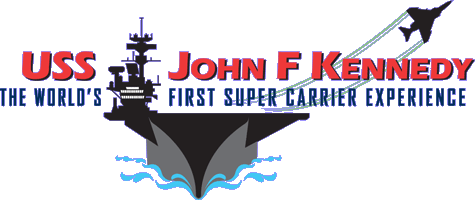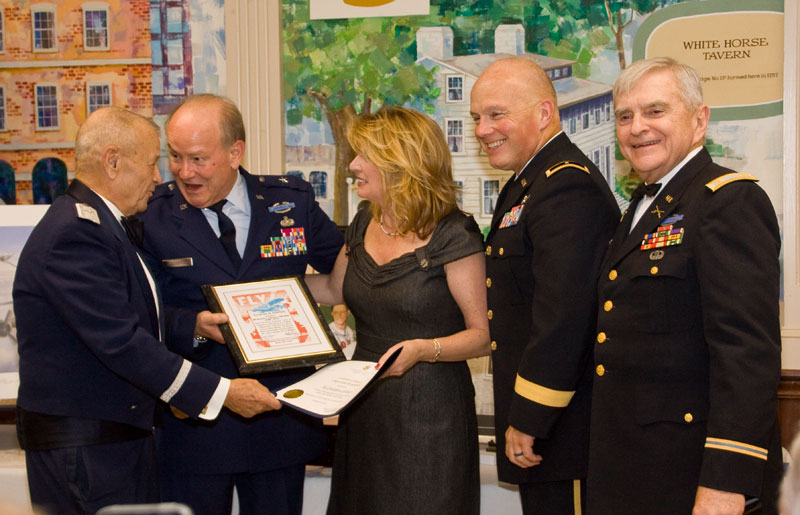Another full house witnessed the induction of three new members and the recognition of the contributions of four other individuals at RI Aviation Hall of Fame’s 14th annual ceremony and dinner on November 19th, 2016. F Company, 1st Battalion, 126th Aviation Regiment (Air Ambulance), which recently received a Meritorious Unit Commendation for its 2011 deployment to Afghanistan, also received a Special Recognition award.
As the selection subcommittee reviewed our ever-increasing inventory of candidates, it became apparent that a large number of them were individuals who served with aviation units of the RI Army National Guard (starting with the 152nd Observation Squadron in the late 1930s), or, after 1948, with the RI Air National Guard.
It became quickly apparent that acknowledging the contributions of this group would be a multi-year process. Working with the Guard, we have developed a short list of 26 potential Guard honorees (either full induction or special recognition) and that list continues to grow as word of our plan circulates.
BG Christopher Callahan, RI Adjutant General, was Guest of Honor. “The Rhode Island National Guard enjoys a rich heritage of aviation achievement, starting in 1915 with the use of LT Gerald Hanley’s flying boat to support training of Battery A of the Coast Artillery,” he stated. “Ever since our first official aviation unit, the 152nd Observation Squadron, was established in 1939, Rhode Island Guard members have played a prominent role in furthering the Guard mission through the air.
“We applaud the RI Aviation Hall Of Fame’s efforts to recognize a number of the unsung heroes of the aviation elements of both the Air and Army National Guard,” he concluded.
Guard inductees for 2016 included:
COL Russell Johnson (1926-2014), affectionately referred to as “Mr. Army National Guard Aviation”, took his first flight with his dad in 1929 and earned his private pilot license in 1943. He would eventually become one of the most experienced aviators in Rhode Island Army Aviation history. He was both a fixed and rotary wing instructor pilot with more than 9,000 military flight hours and 12,000 total hours flight time. He saw combat during WWII as a 19-year-old infantryman, and earned the Bronze Star and Purple Heart during the Battle of Leyte. His Rhode Island Army Aviation career spanned three decades, starting in 1954 as an Aviation Officer with the 43rd Division Artillery at Hillsgrove and concluding in 1977 as the State Aviation Officer at Quonset Point. Russell was Flight Activity Commander at Hillsgrove from 1956 until 1974, and then became the first Rhode Island State Aviation Officer and Army Aviation Support Facility Commander. Though he retired federally at the rank of colonel he was promoted to brigadier general in the Rhode Island Army National Guard shortly before his retirement in 1977. Then-Governor J. Joseph Garrahy declared January 7, 1978 as Russell J. Johnson Day in Rhode Island.
Thomas McLean (1932-living) exceeded his wildest dreams by becoming a USAF F84 Thunderjet pilot right before the end of the Korean War. The Warwick native joined the RI Air National Guard, where he was active from the early 1960s to the mid 1970s. He initially flew the C-46 Commando and the SA-16A Albatross, as well as the U-10 Helio Courier and other assorted aircraft. He also flew F84 fighter jets out of Connecticut, and was Governor John Chafee’s pilot in the 1960s. From the late 1950s until the early 1980s McLean also flew for Pan American World Airways. He lived the Jet Age, making the transition from props to jets. When Pan Am pioneered affordable international air travel with the first major order for Boeing 747s, Tom became the youngest captain in Pan Am’s new 747 fleet.
Special Recognition awards went to:
Captain Karl W Augenstein USAF (1924-1954) was a German immigrant from Cranston who, as a teenager, made the decision to fight for his adopted country. He became a WWII B-24 bomber pilot, flying 11 combat missions before German capitulation in May 1945. As a civilian, he was the corporate pilot for Bulova Watch Company. He returned to the military in 1948 as a 1/LT in the RI Air National Guard. He transitioned to fighters and qualified in the F-51 Mustang, seeing stateside service during the Korean conflict. After qualifying in the F84D Thunderjet, he was killed when he crashed after takeoff from Bradley Field in Connecticut in August 1954 while on a training flight for the Guard.
BG Christopher Callahan, USA now serves as the 44th Adjutant General of the State of RI. Previously, he served as the Director of Aviation and Safety at Quonset. He also served in Iraq as CO of 1st Battalion, 126th Aviation Regiment. Under the command Colonel Callahan, Task Force Dragonwing deployed soldiers from several states and conducted combat support operations throughout the entire Iraqi theater. The unit earned the distinction of being the top Army National Guard aviation unit for 2005. General Callahan, a Massachusetts native, graduated from Fitchburg State College in 1986 and was commissioned through the Early Commissioning Program. General Callahan had an opportunity to transfer as an Infantry Officer in the Massachusetts National Guard to the Rhode Island Army National Guard. He graduated from the rotary wing course in 1988 at Fort Rucker, Alabama.
F Company, 1-126th Aviation (Air Ambulance), RIANG received the Meritorious Unit Citation for executing combat MEDEVAC operations in support of Operation Enduring Freedom in Afghanistan from 3 March 2011 to 24 December 2011. Utilizing four forward support medical evacuation teams, F Company “…demonstrated unparalleled ability to provide effective, lifesaving and agile MEDEVAC support to United States Forces, Afghan National Police, Afghan National Army, local nationals and other Coalition Forces throughout Regional Command-West, Afghanistan.” The citation concluded, “The dedication, determination and performance of F Company, 1-126th Aviation (Air Ambulance) and its Soldiers was in keeping with the finest traditions of military service and reflects great credit upon themselves, Task Force Spearhead, the 1st Air Cavalry Brigade the International Security Assistance Force and the United States Army.”
Our third inductee for 2016 was:
LTC Charles E. Griffith, USAAF (1916-1944) – Griffith was a fighter pilot who fought in the Aleutian Islands campaign of 1942/3, came to China in mid-1944 and joined the 76th Fighter Squadron of the famed 23rd Fighter Group. Born in North Dakota he was a 1935 Hope High School graduate and all-state athlete who went on to RI State College, where he started the school’s wrestling program. He was an intercollegiate champion for three years before his graduation in 1939. He joined the Army Air Corps and was commissioned at Maxwell Field before the war. In Alaska he flew P-39 Aircobras with the 42nd Fighter Squadron. He led the first strafing attack on Kiska Island in September of 1942, earning his first Air Medal. Griffith returned to the US to train new pilots at Henderson Field in Tampa. He saw his first action in China on May 6, 1944. Eleven days later he assumed command of the 76th. He and his wingman were killed when they crashed at Luliang air base while doing a victory roll on return from a mission on December 18, 1944. He had flown 103 combat missions and had four confirmed kills.
Additional special recognition awards went to:
Edward J. Bonaccorsi (1925-2015) – After graduating from Samuel Gorton High School in Warwick he enlisted as an Aviation Cadet in May1943. Failing a pilot medical, he became a mechanic, qualifying in both the B-24 Liberator and the B-29 Stratofortress. He served with the 40th Bombardment Squadron, and spent six months on Tinian Island as the war ended. (Enola Gay was one of the aircraft in this unit, although he was not involved with the final raids of the war.) He studied civil engineering at Indiana Institute of Technology, and was called back to active duty during the Korean War, serving stateside. He worked for both Campanella & Cardi and Tilcon Gammino construction companies before retiring. During his career as a civil engineer he helped to design and build roadways throughout Rhode Island, Southern Massachusetts, Cape Cod, into Connecticut and even as far north as Maine. He was also involved in the design and paving of runways at Otis Air Force Base.
James H. Chute (1918-1993) – Pawtucket native Jim Chute was an 8th Air Force B-17 bomber pilot who earned the Distinguished Flying Cross over Germany. After completing his 35 combat missions in January, 1945, he went to the Pacific Division of Air Transport Command, flying C-54 transports. At the end of the war he participated in Southwest Pacific Wing Project No. 75, a mission that consisted of flying occupation forces from Okinawa to Japan, and evacuating freed POWs on the return flights. Chute, a 1936 graduate of St. Raphael Academy, attended Providence College. He and his wife Katherine owned and operated the Highland Cottage Dairy until 1965. In 1971, he purchased a Dunkin Donuts franchise at the entrance to the old Narragansett Racetrack. He was one of the first Dunkin Donuts operators in Rhode Island, developing two additional locations in Pawtucket and serving on numerous advisory councils and committees within the Dunkin Donuts franchise system.
To view photos from the event, please check out the album on our Facebook page.

